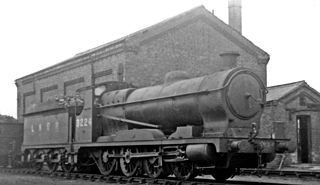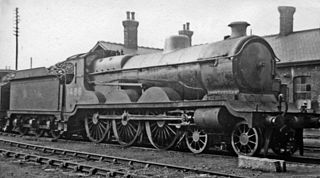This article needs additional citations for verification .(January 2017) |
| GCR Class 8G LNER Class B9 | |||||||||||||||||||||||||||||||||||||||||||||||||||||
|---|---|---|---|---|---|---|---|---|---|---|---|---|---|---|---|---|---|---|---|---|---|---|---|---|---|---|---|---|---|---|---|---|---|---|---|---|---|---|---|---|---|---|---|---|---|---|---|---|---|---|---|---|---|
| |||||||||||||||||||||||||||||||||||||||||||||||||||||
| |||||||||||||||||||||||||||||||||||||||||||||||||||||
| |||||||||||||||||||||||||||||||||||||||||||||||||||||
| |||||||||||||||||||||||||||||||||||||||||||||||||||||
GCR Class 8G was a class of 10 two-cylinder steam locomotives of the 4-6-0 wheel arrangement built in 1906 for the Great Central Railway.
This article needs additional citations for verification .(January 2017) |
| GCR Class 8G LNER Class B9 | |||||||||||||||||||||||||||||||||||||||||||||||||||||
|---|---|---|---|---|---|---|---|---|---|---|---|---|---|---|---|---|---|---|---|---|---|---|---|---|---|---|---|---|---|---|---|---|---|---|---|---|---|---|---|---|---|---|---|---|---|---|---|---|---|---|---|---|---|
| |||||||||||||||||||||||||||||||||||||||||||||||||||||
| |||||||||||||||||||||||||||||||||||||||||||||||||||||
| |||||||||||||||||||||||||||||||||||||||||||||||||||||
| |||||||||||||||||||||||||||||||||||||||||||||||||||||
GCR Class 8G was a class of 10 two-cylinder steam locomotives of the 4-6-0 wheel arrangement built in 1906 for the Great Central Railway.
The locomotive was designed in 1906 and drew heavily from the GCR Class 8F - the biggest difference being that the driving wheels were 1 ft 3 in smaller. Production of the 10 locomotives commenced as soon as the last Class 8F was built. The Class 8Gs used a boiler that had the same diameter as that fitted to both the Class 8F and the Class 8C, but it had a shorter firebox similar to that fitted to the original Class 8s.
Following the merger of the GCR into the London & North Eastern Railway, the class became known as the LNER Class B9. Immediately after the merger, the LNER began converting the class to use superheated boilers - a project that finished in 1929 with all 10 having been converted. These boilers were identical to those used on the LNER Class Q4, and Gresley's anti-vacuum valves were also fitted at the same time. Saturated engines were classified as the Class B9/1, and superheated engines as the Class B9/2. Despite the last B9/1 being converted to a superheated boiler in 1929, the B9/2 class was not renamed to B9 until 1937.
An experimental locomotive conversion was made in 1924 - when No. 6109 was fitted with a superheater, it also gained larger 21" diameter cylinders and piston valves. Despite a large improvement in performance, no further conversions were made, possibly due to both the cost of modification, and the fact that the LNER Class J11 were equally adept at performing the same roles as the Class B9s.
Prior to the creation of the LNER, the Class 8G locomotives were allocated to Gorton and Lincoln. They worked the main goods (Gorton-based locomotives) and fast goods (Lincoln-based locomotives) lines into and out of Manchester. After the grouping, in 1926 all Lincoln locomotives had been moved to Gorton, but 4 moved to Trafford Park in 1927. As LNER locomotives, the Class B9s were still used primarily as goods locomotives, but they did occasionally see use on stopping passenger services and race day specials to both Aintree and Haydock Park. Following the end of the Second World War, the locomotives were allocated to Trafford Park, Stockport and Liverpool, being used for freight services and, in emergencies, passenger services between Liverpool and Manchester.
In 1939, No. 6111 was the first to be withdrawn, but was quickly returned to service after the outbreak of World War II. After the war, withdrawals began again in 1947, and the last locomotive to be withdrawn, ironically that very same No. 6111, was withdrawn in May 1949. No examples survived into preservation.
John George Robinson CBE, was an English railway engineer, and was chief mechanical engineer of the Great Central Railway from 1900 to 1922.

The Caprotti valve gear is a type of steam engine valve gear invented in the early 1920s by Italian architect and engineer Arturo Caprotti. It uses camshafts and poppet valves rather than the piston valves used in other valve gear. While basing his design on automotive valves, Caprotti made several significant departures from this design to adapt the valves for steam. Having agreed a joint-venture with Worcester-based engineering company Heenan & Froude from 1938, Heenan & Froude fully acquired Caprotti post-World War II in 1947.

The Great Central Railway (GCR) Class 8K 2-8-0 is a class of steam locomotive designed for heavy freight. Introduced in 1911, and designed by John G. Robinson, 126 were built for the GCR prior to the First World War. Including wartime construction for the British Army ROD and the post-war GCR Class 8M, the class and its derivatives totalled 666 locomotives.

The Great Central Railway Class 9N, classified A5 by the LNER, was a class of 4-6-2 tank locomotives designed by John G. Robinson for suburban passenger services. They were fitted with superheaters, piston valves and Stephenson valve gear.

The Great Central Railway (GCR) Class 9F was a class of 0-6-2T steam locomotive built between 1891 and 1901. From 1923 the locomotives were redesignated Class N5.

The London and North Eastern Railway Class U1 was a solitary 2-8-0+0-8-2 Beyer-Garratt locomotive designed for banking coal trains over the Worsborough Bank, a steeply graded line in South Yorkshire and part of the Woodhead Route. It was both the longest and the most powerful steam locomotive ever to run in Britain. It was built in 1925 with the motion at each end being based on an existing 2-8-0 design. The original number was 2395, and it was renumbered 9999 in March 1946, and then 69999 after nationalisation in 1948, although it retained its cab-side plate bearing its original number throughout its life. The locomotive ran for some time as an oil burner, and was tried out on the Lickey Incline in 1949–1950 and again, after the electrification of its home line, in 1955. These trials were unsuccessful, and so the locomotive was withdrawn in 1955 and scrapped.

The GCR Class 1 was a class of steam locomotives designed by John G. Robinson for the Great Central Railway, and introduced to service between December 1912 and 1913. In the 1923 grouping, they all passed to the London and North Eastern Railway which placed them in class B2. Their classification was changed to B19 in 1945, and all had been retired by the end of 1947.
The Midland Railway Johnson 0-6-0 were a class of locomotives serving Britain's Midland Railway system in the late 19th and early 20th centuries. Between 1875 and 1908 the Midland Railway, under the control of locomotive superintendents Samuel Waite Johnson and Richard Deeley, ordered 935 goods tender engines of 0-6-0 type, both from the railway's own shops at Derby and various external suppliers. Although there were many variations between different batches both as delivered and as successively rebuilt, all 935 can be regarded as a single series, one of the largest classes of engine on Britain's railways. The locomotives served as late as 1964, but none of them now survive.

The Great Central Railway (GCR) Class 8A was a class of 0-8-0 steam locomotive built between 1902 and 1911 for handling heavy coal trains over the Pennines. They all passed to the LNER in 1923, who redesignated them Class Q4. They were withdrawn from service between 1934 and 1951.

The GCR Class 1B was a class of 2-6-4T (tank) locomotives on the Great Central Railway. They were notable as the first locomotives of the 2-6-4T wheel arrangement to be used by a British standard-gauge railway; there had been two narrow-gauge examples on the Leek & Manifold Valley Light Railway since 1904.
Although overshadowed by the later and more famous steam locomotives that John G. Robinson would go on to design, the Great Central Railway Class 11B 4-4-0 Express Passenger engines were a successful class which totalled 40. Built from 1901 to 1903, in later rebuilt form as 11D, some 11Bs would last in service until 1950. Railwaymen continued to refer to the class as "11B" even after all were rebuilt to 11D. Being contemporary with and to some extent the 4-4-0 version of Robinson's much more numerous 0-6-0 goods class 9J, which were known as "Pom-Poms", the 11Bs acquired the nickname "Pom-Pom Bogies". The London & North Eastern Railway classified the 11Bs, along with their 11C and 11D rebuilds, as Class D9.
GCR Classes 8D and 8E were two pairs of three-cylinder compound steam locomotives of the 4-4-2 wheel arrangement built in 1905 and 1906 for the Great Central Railway.

The GCR Class 11E was a type of 4-4-0 steam locomotive used by the Great Central Railway for express passenger services. Ten were built in the railway's own workshops at Gorton, Manchester during 1913; they remained in service until the mid-1950s.

The Great Central Railway 9K and 9L classes were two related classes of 4-4-2T Atlantic steam locomotives. They were both intended for suburban passenger services. After the 1923 Grouping, they served the LNER as classes C13 and C14.

The GCR Class 9Q, classified B7 by the LNER, was a class of 4-6-0 mixed traffic locomotives designed by John G. Robinson for fast goods, relief passenger and excursion services on the Great Central Railway. They were a smaller wheeled version of Robinson's earlier Class 9P "Lord Faringdon" express passenger class.

The Great Central Railway Class 1A, classified B8 by the LNER, was a class of 4-6-0 mixed-traffic locomotives designed by John G. Robinson for fast goods, relief passenger and excursion services. They were known as the ‘Glenalmond Class’ and were a smaller wheeled version of Robinson's earlier Sir Sam Fay express passenger class, which they closely resembled.
The GCR Class 8C was a class of a pair of 4-6-0 locomotives built for the Great Central Railway in 1903–1904 by Beyer, Peacock and Company. They passed to the London and North Eastern Railway at the 1923 grouping and received the classification B1 They were reclassified B18 in 1943 and both were retired in 1947.

GCR Class 8B was a class of 27 two-cylinder steam locomotives of the 4-4-2 wheel arrangement built between 1903 and 1906 for the Great Central Railway. They were nicknamed "Jersey Lillies" after the famous music star Lillie Langtry.
GCR Class 9P was a design of four-cylinder steam locomotive of the 4-6-0 wheel arrangement built for hauling express passenger trains on the Great Central Railway in England. A total of six were built: one in 1917, and five in 1920. They were sometimes known as the Lord Faringdon class, from the name of the first one built.

The GCR Class 8F was a class of ten 4-6-0 locomotives built for the Great Central Railway in 1906 by Beyer, Peacock and Company to the design of John G. Robinson for working fast goods and fish trains. They passed to the London and North Eastern Railway at the 1923 grouping and received the classification 'B4'.